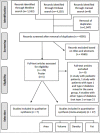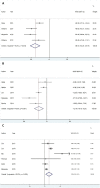Pancreatic size and fat content in diabetes: A systematic review and meta-analysis of imaging studies
- PMID: 28742102
- PMCID: PMC5524390
- DOI: 10.1371/journal.pone.0180911
Pancreatic size and fat content in diabetes: A systematic review and meta-analysis of imaging studies
Abstract
Objectives: Imaging studies are expected to produce reliable information regarding the size and fat content of the pancreas. However, the available studies have produced inconclusive results. The aim of this study was to perform a systematic review and meta-analysis of imaging studies assessing pancreas size and fat content in patients with type 1 diabetes (T1DM) and type 2 diabetes (T2DM).
Methods: Medline and Embase databases were performed. Studies evaluating pancreatic size (diameter, area or volume) and/or fat content by ultrasound, computed tomography, or magnetic resonance imaging in patients with T1DM and/or T2DM as compared to healthy controls were selected. Seventeen studies including 3,403 subjects (284 T1DM patients, 1,139 T2DM patients, and 1,980 control subjects) were selected for meta-analyses. Pancreas diameter, area, volume, density, and fat percentage were evaluated.
Results: Pancreatic volume was reduced in T1DM and T2DM vs. controls (T1DM vs. controls: -38.72 cm3, 95%CI: -52.25 to -25.19, I2 = 70.2%, p for heterogeneity = 0.018; and T2DM vs. controls: -12.18 cm3, 95%CI: -19.1 to -5.25, I2 = 79.3%, p for heterogeneity = 0.001). Fat content was higher in T2DM vs. controls (+2.73%, 95%CI 0.55 to 4.91, I2 = 82.0%, p for heterogeneity<0.001).
Conclusions: Individuals with T1DM and T2DM have reduced pancreas size in comparison with control subjects. Patients with T2DM have increased pancreatic fat content.
Conflict of interest statement
Figures




References
-
- Standards of Medical Care in Diabetes-2016: Summary of Revisions. Diabetes care. 2016;39 Suppl 1:S4–5. Epub 2015/12/24. - PubMed
-
- Cnop M, Vidal J, Hull RL, Utzschneider KM, Carr DB, Schraw T, et al. Progressive loss of beta-cell function leads to worsening glucose tolerance in first-degree relatives of subjects with type 2 diabetes. Diabetes care. 2007;30(3):677–82. Epub 2007/03/01. doi: 10.2337/dc06-1834 - DOI - PubMed
-
- Brozzi F, Nardelli TR, Lopes M, Millard I, Barthson J, Igoillo-Esteve M, et al. Cytokines induce endoplasmic reticulum stress in human, rat and mouse beta cells via different mechanisms. Diabetologia. 2015;58(10):2307–16. Epub 2015/06/24. doi: 10.1007/s00125-015-3669-6 - DOI - PubMed
-
- Butler AE, Janson J, Soeller WC, Butler PC. Increased beta-cell apoptosis prevents adaptive increase in beta-cell mass in mouse model of type 2 diabetes: evidence for role of islet amyloid formation rather than direct action of amyloid. Diabetes. 2003;52(9):2304–14. Epub 2003/08/28. - PubMed
-
- Donath MY, Halban PA. Decreased beta-cell mass in diabetes: significance, mechanisms and therapeutic implications. Diabetologia. 2004;47(3):581–9. Epub 2004/02/10. doi: 10.1007/s00125-004-1336-4 - DOI - PubMed
Publication types
MeSH terms
LinkOut - more resources
Full Text Sources
Other Literature Sources
Medical

